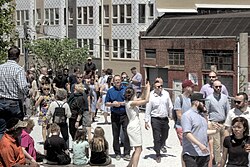Callowhill, Philadelphia
Callowhill was formerly home to large-scale manufacturing and other industries, of which an architectural history has been left in the form of grand old abandoned factories. During the 1970s and 1980s, the population of Callowhill plummeted, and although numbers are rising, it is a fairly unpopulated section of the city compared to surrounding neighborhoods. Recently developers have started to employ adaptive reuse projects, converting them into loft style housing; so much so that many have termed the neighborhood "The Loft District". In 2010, the Callowhill Industrial Historic District was added to the National Register of Historic Places.
Callowhill is physically cut off from its neighbor to the south, Chinatown, by the Vine Street Expressway. This has largely prevented Chinese businesses from spreading north, although some industrial and storage uses by the Chinese community have been placed in Callowhill. Vine Street is also blamed for the abrupt drop in pedestrian life above Chinatown, and the struggle faced by efforts to redevelop this section of the city that lies between Center City and North Philadelphia.


The former Reading Railroad train trestle, the Reading Viaduct, is a defining feature of the Callowhill neighborhood. Neighborhood groups proposed that the abandoned structure be maintained as a public park. The Reading Viaduct park plan gained momentum in 2009 when Philadelphia's Center City District (CCD), and its influential president Paul Levy, became enamored of the idea and ultimately became a partner to help manage the project. CCD announced on Tuesday, February 6, 2018 that the first phase of the quarter-mile-long, elevated park would open in spring 2018. The grand opening of the Rail Park was held on June 14, 2018, attracting a large crowd.
Education
- Career and Academic Development Institute
- Mathematics, Civics and Sciences Charter School
- Roman Catholic High School
Points of interest
- Callowhill Industrial Historic District
- Franklin Music Hall
- Goodman Brothers and Hinlein Company
- Packard Motor Corporation Building
- Philadelphia Lodge No. 2 BPOE (1925)
- Reading Viaduct
- Smaltz Building
- Terminal Commerce Building
- Union Transfer
See also
References
- ^ "About CNA | Callowhill Neighborhood Association". Callowhill.org. Retrieved 2022-03-21.
- ^ Winberg, Michaela (2018-07-06). "How 43 Philly neighborhoods got their names". Billy Penn. Retrieved 2025-01-15.
- ^ Kyriakodis, Harry (February 10, 2016). "The Life And Death Of Callowhill". Hidden City Philadelphia. Retrieved 2018-10-02.
- ^ Carrión, Angelly (2015-03-27). "Property's Photo of the Week: The Loft District Horse and Miss Divine". Philadelphia Magazine. Retrieved 2025-01-15.
- ^ Jaffe, Alan (July 26, 2010). "Gritty Callowhill is recognized as National Historic District". PlanPhilly. Retrieved 2018-10-02.
- ^ Brey, Jared (2016-11-02). "As Rail Park Rises, Chinatown Tries to Stay Chinatown". Philadelphia Magazine. Retrieved 2025-01-15.
- ^ Steuteville, Robert (2016-08-09). "USDOT seeks to reconnect Philly neighborhoods". CNU. Archived from the original on 2017-08-18. Retrieved 2018-10-02.
- ^ "History - Reading Viaduct Project". Reading Viaduct Project. Archived from the original on 2018-10-03. Retrieved 2018-10-02.
- ^ Blumgart, Jake (October 31, 2016). "First phase of Rail Park construction underway". Plan Philly. Retrieved April 6, 2018.
- ^ Romero, Melissa (February 7, 2018). "Rail Park opening delayed until spring 2018". Curbed Philly. Retrieved April 6, 2018.
- ^ Sasko, Claire (2018-06-14). "PHOTOS: Philadelphia's First Rail Park Is Officially Open". Philadelphia Magazine. Retrieved 2018-10-02.
External links
- Callowhill Neighborhood Association
- 9th and Callowhill Redevelopment Area, City Planning Commission, 2005